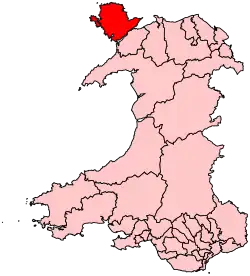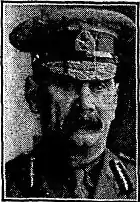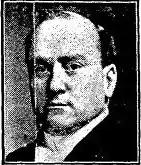1923 Anglesey by-election
The 1923 Anglesey by-election was a parliamentary by-election for the British House of Commons constituency of Anglesey on 7 April 1923.
| |||||||||||||||||||||
| |||||||||||||||||||||
 | |||||||||||||||||||||
| |||||||||||||||||||||
Vacancy
The by-election was caused by the death of the sitting Labour MP, Sir Owen Thomas on 17 January 1923. He had been MP here since winning the seat in 1918.
Election history
Anglesey had been won by either the Liberal Party or the Whigs at every election since 1784, until Thomas surprisingly gained it as an independent Labour candidate in 1918. He held onto it at the 1922 general election, standing as an Independent. The result at the last General Election was as follows;

| Party | Candidate | Votes | % | ±% | |
|---|---|---|---|---|---|
| Independent Labour | Owen Thomas | 11,929 | 54.2 | +3.8 | |
| National Liberal | Robert Thomas | 10,067 | 45.8 | -3.8 | |
| Majority | 1,862 | 8.4 | +7.6 | ||
| Turnout | 21,996 | 80.5 | +11.1 | ||
| Registered electors | 27,320 | ||||
| Independent Labour hold | Swing | +3.8 | |||
Candidates
- The Labour party selected Edward John to defend the seat. He had been Liberal MP for East Denbighshire from December 1910-18. John, a pacifist, had left the Liberals to stand unsuccessfully as a Labour candidate in 1918. He was a prominent Welsh Nationalist.
- The Liberal candidate was again Sir Robert Thomas, the former Wrexham MP who had fought here at the 1922 general election. Thomas was a ship and insurance broker. Thomas had been allied to Lloyd George and had stood as a National Liberal last time. Even though the Liberals nationally had been divided between followers of Asquith and Lloyd George, the local Liberals managed to unite behind Thomas.
- Even though the Coalition Government between the National Liberals and the Unionists had ended, the local Unionists chose not to contest the seat in 1922. However, for the by-election, they decided to intervene and field their own candidate, Richard Owen Roberts. Roberts had stood for the Unionists at Anglesey in 1910. He was a Barrister and sat on the London County Council for Lewisham East.
Campaign
Labour's campaign was supported by visits from national figures such as Arthur Henderson, and a host of Labour MPs from south Wales such as David Watts Morgan, Tom Griffiths, David Grenfell and T. I. Mardy Jones, as well as prominent Welsh nationalist figures such as future Liberal MP William John Gruffydd and Principal Thomas Rees. John called for Welsh Home Rule, even though it was not Labour party policy.
Result
The Liberal party gained the seat from Labour and the Unionists trailed a poor third;

| Party | Candidate | Votes | % | ±% | |
|---|---|---|---|---|---|
| Liberal | Robert Thomas | 11,116 | 53.3 | +7.5 | |
| Labour | Edward John | 6,368 | 30.5 | -23.7 | |
| Unionist | Richard Owen Roberts | 3,385 | 16.2 | N/A | |
| Majority | 4,748 | 22.8 | N/A | ||
| Turnout | 20,869 | 76.4 | -4.1 | ||
| Registered electors | 27,320 | ||||
| Liberal gain from Independent Labour | Swing | +15.6 | |||
The good Liberal result spurred moves towards Liberal reunion at a national level. Within days, the two Liberal groups in the House of Lords decided to accept Viscount Grey as their leader in the Lords.
Aftermath
Sir Robert Thomas sat for the constituency until retiring in 1929. The Liberal Party held the constituency until 1951. The result at the following General election;
| Party | Candidate | Votes | % | ±% | |
|---|---|---|---|---|---|
| Liberal | Robert Thomas | Unopposed | |||
| Registered electors | 28,135 | ||||
| Liberal hold | |||||
John did not stand again. Roberts did not stand again and became a County Court Judge in 1924.
See also
Notes and references
- Craig, F. W. S. (1969). British parliamentary election results 1918-1949 (1 ed.). Glasgow: Political Reference Publications. ISBN 0-900178-019. Page 547
Further reading
- Who's Who: www.ukwhoswho.com
- Debrett's House of Commons 1922
- Trial By Ballot by Ivor RM Davies
- By-Elections in British Politics by Cook and Ramsden
- Welsh History Review, Vol. 14, nos. 1-4 1988-89; E.T. John, devolution and democracy, 1917-24.
- A Vision Of Britain Through Time (Constituency elector numbers)

